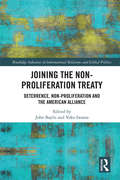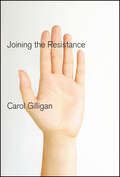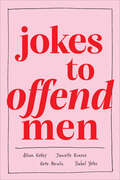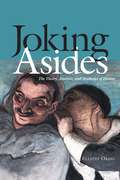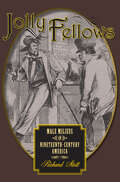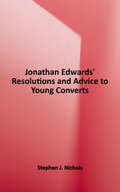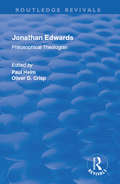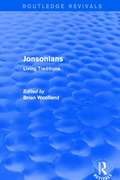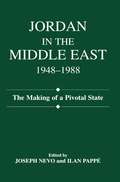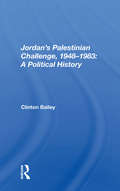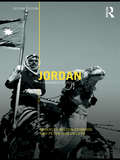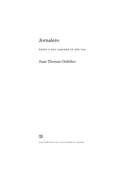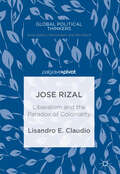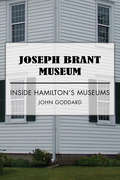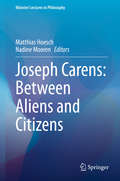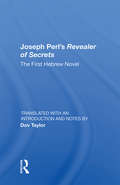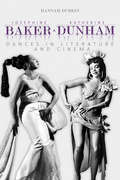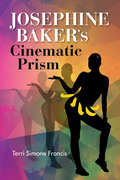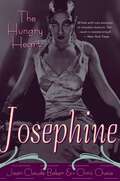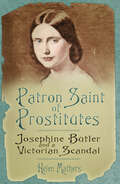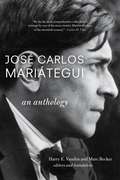- Table View
- List View
Joining the Non-Proliferation Treaty: Deterrence, Non-Proliferation and the American Alliance (Routledge Advances in International Relations and Global Politics)
by John Baylis Yoko IwamaWhat were the calculations made by the US and its major allies in the 1960s when they faced the signing of the Non-Proliferation Treaty (NPT)? These were all states with the technological and financial capabilities to develop and possess nuclear weapons should they wish to do so. In the end, only the United Kingdom and France became nuclear weapon states. Eventually, all of them joined the non-proliferation regime. Leading American, British, Canadian, French, German and Japanese scholars consider key questions that faced the signatories to the NPT: How imperative was nuclear deterrence in facing the perceived threat to their country? How reliable did they think the US extended deterrence was, and how costly would an independent deterrent be both financially and politically? Was there a regional option? How much future was there in the civilian nuclear energy sector for their country and what role would the NPT play in this area? What capabilities needed to be preserved for the country’s future and how could this be made compatible with the NPT? What were the determining factors of deciding whether to join the NPT?
Joining the Resistance
by Carol GilliganSince the publication of her landmark book In a Different Voice, Carol Gilligan has transformed the way we think about women and men and the relations between them. It was ‘the little book that started a revolution’, and with more than 800,000 copies in print it has become one of the most widely read and influential books ever written on gender and human development. In her new book Joining the Resistance Carol Gilligan reflects on the evolution of her thinking and shows how her key ideas were interwoven with her own life experiences. Her work began with the question of voice: who is speaking to whom, in what body, telling what stories about which relationships? By listening carefully she heard a voice that had been held in silence, and in the process realized the extent to which we – both women and men – had been telling false stories about ourselves. In her subsequent work Gilligan found that adolescent girls resisted pressures to disengage themselves from their honest voices, and by joining their resistance she opened the way for the development of a more humane way of thinking about personal and political relationships. For the central conviction of her work today – and the central thesis of this book – is that the requisites for love and the requisites for citizenship in a democratic society are one and the same. Both voice and the desire to live in relationships inherent in our human nature, together with the capacity to resist false authority. Combining autobiographical reflection with an analysis of key questions about gender and human development, this timely and highly readable book by one of America’s greatest contemporary thinkers will appeal to a wide readership.
Jokes to Offend Men
by Allison Kelley Danielle Kraese Kate Herzlin Ysabel YatesA man walks into a bar. It&’s a low one, so he gets a promotion within his first six months on the job. Four comedy writers transform classic joke setups into sharp commentary about the everyday and structural sexism that pervades all facets of life. Jokes to Offend Men arms readers with humorous quips to shut down workplace underminers, condescending uncles, and dismissive doctors, or to share with their exhausted friends at the end of a long day. A cutting, cathartic spin on the old-fashioned joke book, Jokes to Offend Men is a refreshing reclamation of a tired form for anyone who's ever been told to "lighten up, it's just a joke!"
Joking Asides: The Theory, Analysis, and Aesthetics of Humor
by Elliott OringNothing in the understanding of humor is as simple as it might seem. In Joking Asides, Elliott Oring confronts the problems of humor, analyzing the key contemporary approaches to its study and addressing controversial topics with new empirical data and insights. A folklorist drawn to the study of humor, Oring developed his formulation of “appropriate incongruity” as a frame to understand what jokes must do to produce humor. He tests appropriate incongruity against other major positions in the field, including the general theory of verbal humor, conceptual integration theory, benign violation theory, and false-belief theory. Oring draws on the work of scholars from several disciplines—anthropology, folklore, philosophy, psychology, linguistics, and literature—to ask basic questions about the construction and evolution of jokes, untangle the matter of who the actual targets of a joke might be, and characterize the artistic qualities of jokes and joke performances. Although Oring guides the reader through a forest of jokes and joke genres, this is not a joke book. A major work from a major scholar, Joking Asides is a rigorous exploration of theoretical approaches to jokes and their functions and is filled with disquieting questions, penetrating criticisms, and original observations. Written in a clear and accessible style, this book will prove valuable to any scholar or student who takes matters of jokes and joking seriously.
Jolly Fellows: Male Milieus in Nineteenth-Century America (Gender Relations in the American Experience)
by Richard Stott"Jolly fellows," a term that gained currency in the nineteenth century, referred to those men whose more colorful antics included brawling, heavy drinking, gambling, and playing pranks. Reforms, especially the temperance movement, stigmatized such behavior, but pockets of jolly fellowship continued to flourish throughout the country. Richard Stott scrutinizes and analyzes this behavior to appreciate its origins and meaning. Stott finds that male behavior could be strikingly similar in diverse locales, from taverns and boardinghouses to college campuses and sporting events. He explores the permissive attitudes that thrived in such male domains as the streets of New York City, California during the gold rush, and the Pennsylvania oil fields, arguing that such places had an important influence on American society and culture. Stott recounts how the cattle and mining towns of the American West emerged as centers of resistance to Victorian propriety. It was here that unrestrained male behavior lasted the longest, before being replaced with a new convention that equated manliness with sobriety and self-control.Even as the number of jolly fellows dwindled, jolly themes flowed into American popular culture through minstrelsy, dime novels, and comic strips. Jolly Fellows proposes a new interpretation of nineteenth-century American culture and society and will inform future work on masculinity during this period.
Jonathan Edwards' Resolutions and Advice To Young Converts
by Jonathan EdwardsWhile completing his preparation for the ministry, Jonathan Edwards wrote seventy resolutions that guided him throughout his life. About twenty years later he wrote a letter to young Deborah Hatheway, a new convert in a nearby town, advising her concerning the Christian life. <p><p>These two writings, often reprinted during the eighteenth and nineteenth centuries, overflow with straightforward and biblically sound advice. This advice is as current today as it was in the 1700s, and it far surpasses the how-to books now overrunning bookstores.
Jonathan Edwards: Philsophical Theologian
by Oliver D. CrispThis title was first published in 2003. It has often been claimed that Jonathan Edwards (1703-1758) was America's greatest philosopher and theologian. From literary criticism of his sermons to philosophical assessments of his metaphysics, there has been a burgeoning industry in Edwardsian studies, but there has been no one place where an exploration of the theology and philosophy of Edwards has been brought together. 2003 marks the tercentenary date of the birth of Jonathan Edwards. This book draws together specially-commissioned contributions from philosophers and theologians from the USA and UK, to present new analytic philosophical and theological thinking on Edwards in a way that reflects Edwards' own concerns, as well as those current in the academy.
Jonsonians: Living Traditions (Routledge Revivals Ser.)
by Brian WoollandThis title was first published in 2003. "Jonsonians" explores the theatrical traditions within which Ben Jonson was working, investigates the ways in which his work has influenced and informed the development of theatre from the early 17th century to the present day, and examines Jonson's theatre in relation to 20th- and 21st-century traditions of performance. It argues that although Jonsonian traditions are rarely acknowledged, they are vibrant and powerful forces that are very much alive today in the theatre of writers and directors as diverse as Caryl Churchill, David Mamet, Spike Lee, John Arden, Alan Ayckbourn and Peter Barnes. The book opens with essays on "Poetaster", "Sejanus", "Bartholomew Fair", "The New Inn" and "The Magnetic Lady" - each of which interrogates, in a variety of ways, the notion of "Jonsonian" theatre and considers the relationships of Jonson's theatre to classical traditions, to his contemporaries in England and Europe, and to modern performance practice and theory. The second section of the book includes essays on "The Sons of Ben" (including Richard Brome) Aphra Behn and "Daughters of Ben" (women working in the theatre in the post-Restoration period). The book concludes with an extensive section devoted to modern day Jonsonians, exploring how reading their work as Jonsonian might alter perceptions of contemporary theatre, and how seeing them as contemporary "Jonsonians" might affect our understanding of Jonson's theatre.
Jordan in the Middle East, 1948-1988: The Making of Pivotal State
by Ilan Pappé Joseph NevoA collection of articles assessing Jordan's position in the region in light of its quest for legitimacy as a state and as a Hashemite monarchy. Describes the country's role in the conflict with Israel and the balance of power between Palestinians and East Bankers.
Jordan's Palestinian Challenge, 1948-1983: A Political History
by Clinton BaileyTwo-thirds of all Palestinians are Jordanian citizens living on the East and West Banks; a sizable number also reside and work in various parts of the Arabian Peninsula. With the questions of ultimate sovereignty over the West Bank and the Gaza Strip attracting much international attention since Israel's occupation of these areas in 1967, the solution to the Palestinian question is often seen as entirely dependent on Palestinian relations with Israel, despite the fact that only one-third of the Palestinians live in the occupied territories. In contrast, Palestinian relations with the Arab states, including Jordan, are generally portrayed as a sideshow to the main theater of conflict. This book examines the thirty-five-year struggle between the Hashimite monarchy and the forces of Palestinian nationalism over the future identity, and perhaps location, of those two-thirds of the Palestinian people who have been Jordanian subjects since 1948. Dr. Bailey bases his study on "open" sources: reports appearing in the Arab, Israeli, and world press, in addition to academic studies and published memoirs of persons involved in the events described, providing an accurate portrayal of the significant developments in Jordan's Palestinian challenge over the past thirty-five years.
Jordan: A Hashemite Legacy (The Contemporary Middle East #Vol. 7)
by Beverley Milton-Edwards Peter HinchcliffeCreated as a mechanism for maintaining British influence through a local patron, Jordan’s future never looked certain. Nevertheless, under the leadership of the Hashemite monarchy led by Abdullah and then his grandson Hussein, the Kingdom of Jordan became a permanent feature on the map of the modern Middle East. Under the rule of King Abdullah II, Jordan has remained an influential regional player in the Middle East Peace Process, its strategic position on the borders of Palestine, Israel, Egypt, Saudi Arabia and Iraq ensuring that it cannot be overlooked in the regional and international politics. Updated and expanded to include recent developments in Jordan and the Middle East, the new edition includes coverage and discussion of: the reign of King Abdullah II the involvement of the US in the Iraq war and the effect on this on Jordan’s alignment with the West the country’s recent economic growth, with an emphasis on economic liberalisation, privatisation, promotion of tourism and encouragement of foreign investment the position of Jordan as a point of continuity in an increasingly unstable Middle East. This volume, intended for both academic and general readers, offers an overview of the history, politics and economics of this fascinating country and its role in a region disfigured by the Arab-Israeli conflict.
Jordanian-Israeli Relations: The Peacebuilding Experience (Routledge Studies in Middle Eastern Politics)
by Mutayyam al O'ranJordan’s peace treaty with Israel was unique as it bore the promise of what was termed a "warm" peace between the two warring countries. With legitimacy provided by Madrid and Oslo, hopes for "true" peace, as the Israelis would describe it, were high. This book explores the Jordanian-Israeli relations from a Jordanian perspective, focusing on the peacebuilding experience since 1994. In examining the reasons why a warm peace has not developed, the book focuses on the interplay between agency and structure on the Jordanian side, in relation to the Israeli-Palestinian context. In doing so, the book discusses the role of the various Jordanian leadership layers in the process and brings to the light intra-societal dynamics and particularities of the Jordanian social construct. With research based on the premise that international relations are social constructions, meaning that facts are theory-laden and contexts matter to political actors since they influence their understanding of conflict and impact upon their decisions, the book also serves as an example of the application of an inter-disciplinary approach to analyzing conflicts and subsequent peacebuilding experiences. This book will be of interests to students of Politics and International Relations, History, Middle Eastern Studies and Social Studies, in particular those interested in the areas of Conflict Resolution and Peacebuilding.
Jornalero
by Juan Thomas OrdonezThe United States has seen a dramatic rise in the number of informal day labor sites in the last two decades. Typically frequented by Latin American men (mostly "undocumented" immigrants), these sites constitute an important source of unskilled manual labor. Despite day laborers' ubiquitous presence in urban areas, however, their very existence is overlooked in much of the research on immigration. While standing in plain view, these jornaleros live and work in a precarious environment: as they try to make enough money to send home, they are at the mercy of unscrupulous employers, doing dangerous and underpaid work, and, ultimately, experiencing great threats to their identities and social roles as men. Juan Thomas Ordóñez spent two years on an informal labor site in the San Francisco Bay Area, documenting the harsh lives led by some of these men during the worst economic crisis that the United States has seen in decades. He earned a perspective on the immigrant experience based on close relationships with a cohort of men who grappled with constant competition, stress, and loneliness. Both eye-opening and heartbreaking, the book offers a unique perspective on how the informal economy of undocumented labor truly functions in American society.
Jose Rizal: Liberalism And The Paradox Of Coloniality (Global Political Thinkers Ser.)
by Lisandro E. ClaudioThe global history of liberalism has paid too much attention to the West, neglecting the contributions of liberals from colonial nations. This book mines the thought of Filipino propagandist and novelist, Jose Rizal, to present a vision of liberalism for the colonized. It is both an introduction to Rizal and a treatise on rights, freedom, and tyranny in colonial contexts. Though a work on history, it responds to the illiberal present of rising authoritarianism and populism.
Joseph Brant Museum: Inside Hamilton's Museums
by John GoddardInside Hamilton’s Museums helps to satisfy a growing curiosity about Canada’s steel capital as it evolves into a post-industrial city and cultural destination. In this special excerpt we visit Burlington's Joseph Brant Museum, which commemorates the Mohawk leader Thayendanegea, or Joseph Brant, who built his home on a site bordering modern-day Hamilton. John Goddard takes us on a detailed tour of the historic home, providing fascinating historical background and insight.
Joseph Carens: Between Aliens and Citizens (Münster Lectures in Philosophy #6)
by Matthias Hoesch Nadine MoorenThis book offers a critical discussion of Joseph Carens’s main works in migration ethics covering themes such as migration, naturalization, citizenship, culture, religion and economic equality. The volume is published on the occasion of the annual Münster Lectures in Philosophy held by Joseph Carens in the fall of 2018. It documents the intellectual exchange with the well-known philosopher Joseph Carens by offering critical contributions on Carens’s work and commentaries of Carens as a reply to these critical contributions. With his various works on migration ethics, Joseph Carens must be seen as one of the leading academics in the political and ethical discourse of migration in the last years. The topic of migration raises questions not only regarding naturalization and citizenship but also cultural, economic and religious differences between aliens, citizens and persons whose status lies in between and calls for further determination. Such questions gain more and more importance in our globalized world as can be seen for example in the context of the refugee crisis in the European Union and the U.S. The book covers different systematic topics of Carens’s work as can be found in his widely read book “The Ethics of Immigration” but also in further publications. It provides papers with critical discussions of Carens’s work as well as his responses to these, thus enabling and documenting the fruitful dialogue between the contributors and Carens himself. The aim of this book is to sharpen and shed light on Carens’s arguments concerning migration by offering new and critical perspectives and fine-grained analyses.
Joseph Chamberlain: International Statesman, National Leader, Local Icon
by I. Cawood C. UptonWinston Churchill described Joseph Chamberlain as 'the man who made the weather' for twenty years in British politics between the 1880s and the 1900s. This volume contains contributions on every aspect of Chamberlain's career, including international and cultural perspectives hitherto ignored by his many biographers. It breaks his career into three aspects: his career as an international statesman, defender of British interests and champion of imperial federation; his role as a national leader, opposing Gladstone's crusade for Irish home rule by forming an alliance with the Conservatives, campaigning for social reform and finally advocating a protectionist economic policy to promote British business; and the aspect for which he is still celebrated in his adopted city, as the provider of sanitation, gas lighting, clean water and cultural achievement for Birmingham – a model of civic regeneration that still inspires modern politicians such as Michael Heseltine, Tristram Hunt and David Willetts.
Joseph Perl's Revealer Of Secrets: The First Hebrew Novel
by Dov TaylorThe dawning of the nineteenth century found the Jews of Eastern Europe torn between the forces of progress and reaction as they took their first tentative steps toward the modern world. In a war of words and of books, Haskaia–the Jewish Enlightenment–did battle with the religious revival movement known as Hasidism. Perl, an ardent advocate of Enlightenment, unleashed the opening salvo with the publication in 1819 of Revealer of Secrets. The novel tried to pass itself off as a hasidic holy book when it was, in fact, a broadside against Hasidism–a parody of its teachings and of the language of its holy books. The outraged hasidim responded by buying up and burning as many copies as they could. Dov Taylor's careful translation and commentary make this classic of Hebrew literature available and accessible to the contemporary English-speaking reader while preserving the integrity and bite of Perl's original. With Hasidism presently enjoying a remarkable rebirth, the issues in Revealer of Secrets are all the more relevant to those seeking to balance reason and faith. As the first Hebrew novel, the work will also be of great interest to students of modern Hebrew literature and modern Jewish history.
Josephine Baker and Katherine Dunham: Dances in Literature and Cinema
by Hannah DurkinJosephine Baker and Katherine Dunham were the two most acclaimed and commercially successful African American dancers of their era and among the first black women to enjoy international screen careers. Both also produced fascinating memoirs that provided vital insights into their artistic philosophies and choices. However, difficulties in accessing and categorizing their works on the screen and on the page have obscured their contributions to film and literature.Hannah Durkin investigates Baker and Dunham’s films and writings to shed new light on their legacies as transatlantic artists and civil rights figures. Their trailblazing dancing and choreography reflected a belief that they could use film to confront racist assumptions while also imagining—within significant confines—new aesthetic possibilities for black women. Their writings, meanwhile, revealed their creative process, engagement with criticism, and the ways each mediated cultural constructions of black women's identities. Durkin pays particular attention to the ways dancing bodies function as ever-changing signifiers and de-stabilizing transmitters of cultural identity. In addition, she offers an overdue appraisal of Baker and Dunham's places in cinematic and literary history.
Josephine Baker's Cinematic Prism
by Terri Simone FrancisA history and in-depth analysis of the film career of the iconic Black star, activist, and French military intelligence agent. Josephine Baker, the first Black woman to star in a major motion picture, was both liberated and delightfully undignified, playfully vacillating between allure and colonialist stereotyping. Nicknamed the &“Black Venus,&” &“Black Pearl,&” and &“Creole Goddess,&” Baker blended the sensual and the comedic when taking 1920s Europe by storm. Back home in the United States, Baker&’s film career brought hope to the Black press that a new cinema centered on Black glamour would come to fruition. In Josephine Baker&’s Cinematic Prism, Terri Simone Francis examines how Baker fashioned her celebrity through cinematic reflexivity, an authorial strategy in which she placed herself, her persona, and her character into visual dialogue. Francis contends that though Baker was an African American actress who lived and worked in France exclusively with a white film company, white costars, white writers, and white directors, she holds monumental significance for African American cinema as the first truly global Black woman film star. Francis also examines the double-talk between Baker and her characters in Le Pompier de Folies Bergère, La Sirène des Tropiques, Zou Zou, Princesse Tam Tam, and The French Way, whose narratives seem to undermine the very stardom they offered. In doing so, Francis illuminates the most resonant links between emergent African American cinephilia, the diverse opinions of Baker in the popular press, and African Americans&’ broader aspirations for progress toward racial equality. Examining an unexplored aspect of Baker&’s career, Josephine Baker&’s Cinematic Prism deepens the ongoing conversation about race, gender, and performance in the African diaspora.
Josephine Baker: The Hungry Heart
by Chris Chase Jean-Claude BakerBased on twenty years of research and thousands of interviews, this authoritative biography of performer Josephine Baker (1906-1975) provides a candid look at her tempestuous life. Born into poverty in St. Louis, the uninhibited chorus girl became the sensation of Europe and the last century's first black sex symbol. A heroine of the French Resistance in World War II, she entranced figures as diverse as de Gaulle, Tito, Castro, Princess Grace, two popes, and Martin Luther King, Jr. Yet Josephine was also, as one critic put it, "a monster who made Joan Crawford look like the Virgin Mary." Jean-Claude Baker's book also reveals her outbursts that resulted in lasting feuds, her imperious treatment of family and entourage members, and her ambivalent attitudes concerning her ethnic background.Reconciling Josephine's many personas—Jazz-age icon, national hero of France, proponent of Civil Rights, mother of children from across the globe—Josephine: The Hungry Heart gives readers the inside story on a star unlike any other before or since.
Josephine Butler: Patron Saint of Prostitutes
by Helen MathersThe ‘steel rape’ of women is a scandal that is almost forgotten today.In Victorian England, police forces were granted powers to force any woman they suspected of being a ‘common prostitute’ to undergo compulsory and invasive medical examinations, while women who refused to submit willingly could be arrested and incarcerated. This scandal was exposed by Josephine Butler, an Evangelical campaigner who did not rest until she had ended the violation and helped repeal the Act that governed it. She went on to campaign against child prostitution, the trafficking of girls from Britain to Europe, and government-sponsored brothels in India. In addition, Josephine was instrumental in raising the age of consent from 13 to 16.Josephine Butler is the poignant tale of a nineteenth-century woman who challenged taboos and conventions in order to campaign for the rights of her gender. Her story is compelling – and unforgettable.
Joshimath - Vikas ya Vinash?: जोशीमठ - विकास या विनाश?
by Shivendra Suryavanshi"जोशीमठ - विकास या विनाश?" शिवेन्द्र सूर्यवंशी द्वारा लिखित एक पुस्तक है जो उत्तराखंड के जोशीमठ क्षेत्र में हो रहे पर्यावरणीय और विकासात्मक परिवर्तनों पर केंद्रित है। पुस्तक का मुख्य उद्देश्य जोशीमठ के विकास और पर्यावरणीय प्रभावों के बीच के संबंधों की गहराई से जांच करना है। यहाँ इस पुस्तक का सारांश प्रस्तुत है: परिचय और पृष्ठभूमि, विकास की यात्रा, विकास के सकारात्मक पहलू, विनाश के चिन्ह, स्थानीय निवासियों की आवाज़, विकास और पर्यावरण के बीच संतुलन और निष्कर्ष और भविष्य की राह। शिवेन्द्र सूर्यवंशी ने इस पुस्तक में गहन शोध और स्थानीय अनुभवों के माध्यम से जोशीमठ के विकास और पर्यावरणीय चुनौतियों को प्रस्तुत किया है। यह पुस्तक उन सभी के लिए महत्वपूर्ण है जो विकास और पर्यावरण के बीच के जटिल संबंधों को समझना चाहते हैं और जोशीमठ जैसे संवेदनशील क्षेत्रों में टिकाऊ विकास की संभावनाओं का अन्वेषण करना चाहते हैं।
José Carlos Mariátegui: An Anthology
by Marc Becker Harry VandenJosé Carlos Mariátegui is one of Latin America’s most profound but overlooked thinkers. A self-taught journalist, social scientist, and activist from Peru, he was the first to emphasize that those fighting for the revolutionary transformation of society must adapt classical Marxist theory to the particular conditions of Latin American. He also stressed that indigenous peoples must take an active, if not leading, role in any revolutionary struggle. Today Latin America is the scene of great social upheaval. More progressive governments are in power than ever before, and grassroots movements of indigenous peoples, workers, and peasants are increasingly shaping the political landscape. The time is perfect for a rediscovery of Mariátegui, who is considered an intellectual precursor of today’s struggles in Latin America but virtually unknown in the English-speaking world. This volume collects his essential writings, including many that have never been translated and some that have never been published. The scope of this collection, masterful translation, and thoughtful commentary make it an essential book for scholars of Latin America and all of those fighting for a new world, waiting to be born.
José Ingenieros: Yesterday and Today, Critical Readings (Classic and Contemporary Latin American Social Theory)
by Maximiliano E. KorstanjeMaximiliano Korstanje presents an overview and analysis of the work of the Argentinian sociologist and physician, José Ingenieros (1877–1925). In fact, José Ingenieros was a seminal scholar who contributed directly to the formation of sociology in Latin America. Born in Palermo, Italy Ingenieros grew up in Buenos Aires, Argentina. He trained in medicine, psychiatry, sociology and philosophy; he devoted much of his life to addressing societal challenges such as mass migration, imperialism, marginality, criminality and social identity.Korstanje takes in turn the key areas of Ingenieros’s work and examines how his thinking can be brought to bear on the social challenges of today. In particular his work on mass migration and the “Other” have echoes in the problems facing many countries in the early twenty-first century. It is a valuable resource for scholars and students looking to better understand this key figure in Argentinian – and Latin American – sociology in the early twentieth century.
